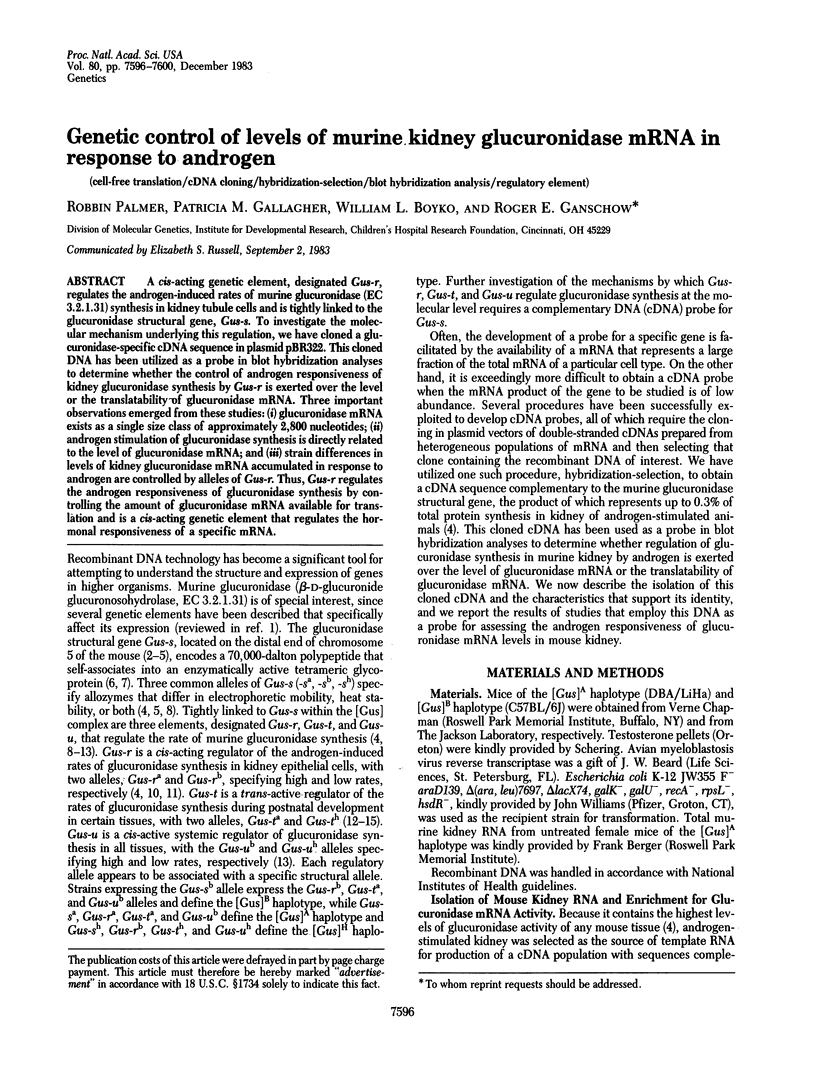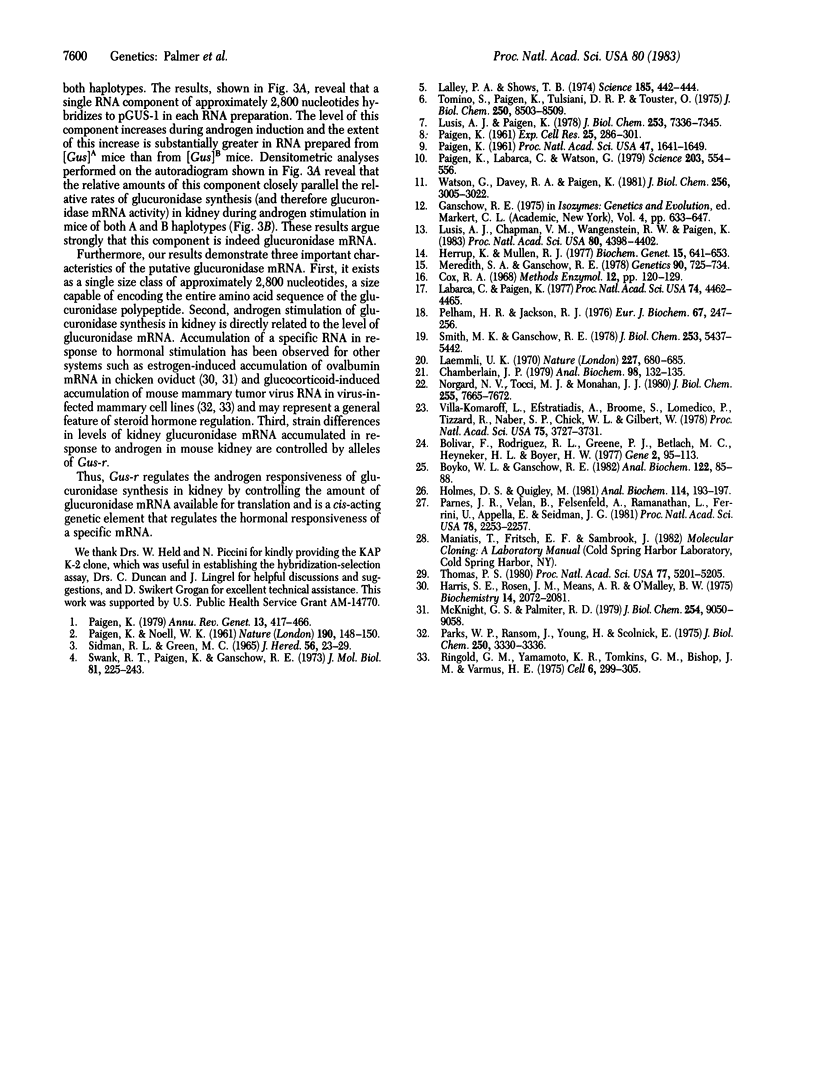Abstract
A cis-acting genetic element, designated Gus-r, regulates the androgen-induced rates of murine glucuronidase (EC 3.2.1.31) synthesis in kidney tubule cells and is tightly linked to the glucuronidase structural gene, Gus-s. To investigate the molecular mechanism underlying this regulation, we have cloned a glucuronidase-specific cDNA sequence in plasmid pBR322. This cloned DNA has been utilized as a probe in blot hybridization analyses to determine whether the control of androgen responsiveness of kidney glucuronidase synthesis by Gus-r is exerted over the level or the translatability of glucuronidase mRNA. Three important observations emerged from these studies: (i) glucuronidase mRNA exists as a single size class of approximately 2,800 nucleotides; (ii) androgen stimulation of glucuronidase synthesis is directly related to the level of glucuronidase mRNA; and (iii) strain differences in levels of kidney glucuronidase mRNA accumulated in response to androgen are controlled by alleles of Gus-r. Thus, Gus-r regulates the androgen responsiveness of glucuronidase synthesis by controlling the amount of glucuronidase mRNA available for translation and is a cis-acting genetic element that regulates the hormonal responsiveness of a specific mRNA.
Full text
PDF




Images in this article
Selected References
These references are in PubMed. This may not be the complete list of references from this article.
- Bolivar F., Rodriguez R. L., Greene P. J., Betlach M. C., Heyneker H. L., Boyer H. W., Crosa J. H., Falkow S. Construction and characterization of new cloning vehicles. II. A multipurpose cloning system. Gene. 1977;2(2):95–113. [PubMed] [Google Scholar]
- Boyko W. L., Ganschow R. E. Rapid identification of Escherichia coli transformed by pBR322 carrying inserts at the PstI Site. Anal Biochem. 1982 May 1;122(1):85–88. doi: 10.1016/0003-2697(82)90254-8. [DOI] [PubMed] [Google Scholar]
- Chamberlain J. P. Fluorographic detection of radioactivity in polyacrylamide gels with the water-soluble fluor, sodium salicylate. Anal Biochem. 1979 Sep 15;98(1):132–135. doi: 10.1016/0003-2697(79)90716-4. [DOI] [PubMed] [Google Scholar]
- Harris S. E., Rosen J. M., Means A. R., O'Malley B. W. Use of a specific probe for ovalbumin messenger RNA to quantitate estrogen-induced gene transcripts. Biochemistry. 1975 May 20;14(10):2072–2081. doi: 10.1021/bi00681a006. [DOI] [PubMed] [Google Scholar]
- Herrup K., Mullen R. J. Biochemical and genetic factors in the heat inactivation of murine beta-glucuronidase. Biochem Genet. 1977 Aug;15(7-8):641–653. doi: 10.1007/BF00484095. [DOI] [PubMed] [Google Scholar]
- Holmes D. S., Quigley M. A rapid boiling method for the preparation of bacterial plasmids. Anal Biochem. 1981 Jun;114(1):193–197. doi: 10.1016/0003-2697(81)90473-5. [DOI] [PubMed] [Google Scholar]
- Hudec P. P., Sonnenfeld P. Lysosomal and microsomal glucuronidase: genetic variant alters electrophoretic mobility of both hydrolases. Science. 1974 Aug 2;185(4149):442–444. [PubMed] [Google Scholar]
- Labarca C., Paigen K. MRNA-directed synthesis of catalytically active mouse beta-glucuronidase in Xenopus oocytes. Proc Natl Acad Sci U S A. 1977 Oct;74(10):4462–4465. doi: 10.1073/pnas.74.10.4462. [DOI] [PMC free article] [PubMed] [Google Scholar]
- Laemmli U. K. Cleavage of structural proteins during the assembly of the head of bacteriophage T4. Nature. 1970 Aug 15;227(5259):680–685. doi: 10.1038/227680a0. [DOI] [PubMed] [Google Scholar]
- Lusis A. J., Chapman V. M., Wangenstein R. W., Paigen K. Trans-acting temporal locus within the beta-glucuronidase gene complex. Proc Natl Acad Sci U S A. 1983 Jul;80(14):4398–4402. doi: 10.1073/pnas.80.14.4398. [DOI] [PMC free article] [PubMed] [Google Scholar]
- Lusis A. J., Paigen K. The large scale isolation of mouse beta-glucuronidase and comparison of allozymes. J Biol Chem. 1978 Oct 25;253(20):7336–7345. [PubMed] [Google Scholar]
- McKnight G. S., Palmiter R. D. Transcriptional regulation of the ovalbumin and conalbumin genes by steroid hormones in chick oviduct. J Biol Chem. 1979 Sep 25;254(18):9050–9058. [PubMed] [Google Scholar]
- Meredith S. A., Ganschow R. E. Apparent trans control of murine beta-glucuronidase synthesis by a temporal genetic element. Genetics. 1978 Dec;90(4):725–734. doi: 10.1093/genetics/90.4.725. [DOI] [PMC free article] [PubMed] [Google Scholar]
- Norgard M. V., Tocci M. J., Monahan J. J. On the cloning of eukaryotic total poly(A)-RNA populations in Escherichia coli. J Biol Chem. 1980 Aug 25;255(16):7665–7672. [PubMed] [Google Scholar]
- PAIGEN K., NOELL W. K. Two linked genes showing a similar timing of expression in mice. Nature. 1961 Apr 8;190:148–150. doi: 10.1038/190148a0. [DOI] [PubMed] [Google Scholar]
- PAIGEN K. The effect of mutation on the intracellular location of beta-glucuronidase. Exp Cell Res. 1961 Nov;25:286–301. doi: 10.1016/0014-4827(61)90280-4. [DOI] [PubMed] [Google Scholar]
- PAIGEN K. The genetic control of enzyme activity during differentiation. Proc Natl Acad Sci U S A. 1961 Oct 15;47:1641–1649. doi: 10.1073/pnas.47.10.1641. [DOI] [PMC free article] [PubMed] [Google Scholar]
- Paigen K. Acid hydrolases as models of genetic control. Annu Rev Genet. 1979;13:417–466. doi: 10.1146/annurev.ge.13.120179.002221. [DOI] [PubMed] [Google Scholar]
- Paigen K., Labarca C., Watson G. A regulatory locus for mouse beta-glucuronidase induction, Gur, controls messenger RNA activity. Science. 1979 Feb 9;203(4380):554–556. doi: 10.1126/science.760204. [DOI] [PubMed] [Google Scholar]
- Parks W. P., Ransom J. C., Young H. A., Scolnick E. M. Mammary tumor virus induction by glucocorticoids. Characterization of specific transcriptional regulation. J Biol Chem. 1975 May 10;250(9):3330–3336. [PubMed] [Google Scholar]
- Parnes J. R., Velan B., Felsenfeld A., Ramanathan L., Ferrini U., Appella E., Seidman J. G. Mouse beta 2-microglobulin cDNA clones: a screening procedure for cDNA clones corresponding to rare mRNAs. Proc Natl Acad Sci U S A. 1981 Apr;78(4):2253–2257. doi: 10.1073/pnas.78.4.2253. [DOI] [PMC free article] [PubMed] [Google Scholar]
- Pelham H. R., Jackson R. J. An efficient mRNA-dependent translation system from reticulocyte lysates. Eur J Biochem. 1976 Aug 1;67(1):247–256. doi: 10.1111/j.1432-1033.1976.tb10656.x. [DOI] [PubMed] [Google Scholar]
- Ringold G. M., Yamamoto K. R., Tomkins G. M., Bishop M., Varmus H. E. Dexamethasone-mediated induction of mouse mammary tumor virus RNA: a system for studying glucocorticoid action. Cell. 1975 Nov;6(3):299–305. doi: 10.1016/0092-8674(75)90181-6. [DOI] [PubMed] [Google Scholar]
- SIDMAN R. L., GREEN M. C. RETINAL DEGENERATION IN THE MOUSE: LOCATION OF THE RD LOCUS IN LINKAGE GROUP XVII. J Hered. 1965 Jan-Feb;56:23–29. doi: 10.1093/oxfordjournals.jhered.a107364. [DOI] [PubMed] [Google Scholar]
- Smith K., Ganschow R. E. Turnover of murine beta-glucuronidase. Comparison among liver, kidney, and spleen and between lysosomes and microsomes. J Biol Chem. 1978 Aug 10;253(15):5437–5442. [PubMed] [Google Scholar]
- Swank R. T., Paigen K., Ganschow R. E. Genetic control of glucuronidase induction in mice. J Mol Biol. 1973 Dec 5;81(2):225–243. doi: 10.1016/0022-2836(73)90191-5. [DOI] [PubMed] [Google Scholar]
- Thomas P. S. Hybridization of denatured RNA and small DNA fragments transferred to nitrocellulose. Proc Natl Acad Sci U S A. 1980 Sep;77(9):5201–5205. doi: 10.1073/pnas.77.9.5201. [DOI] [PMC free article] [PubMed] [Google Scholar]
- Tomino S., Paigen K., Tulsiani D. R., Touster O. Purification and chemical properities of mouse liver lysosomal (L form) beta-glucuronidase. J Biol Chem. 1975 Nov 10;250(21):8503–8509. [PubMed] [Google Scholar]
- Villa-Komaroff L., Efstratiadis A., Broome S., Lomedico P., Tizard R., Naber S. P., Chick W. L., Gilbert W. A bacterial clone synthesizing proinsulin. Proc Natl Acad Sci U S A. 1978 Aug;75(8):3727–3731. doi: 10.1073/pnas.75.8.3727. [DOI] [PMC free article] [PubMed] [Google Scholar]
- Watson G., Davey R. A., Labarca C., Paigen K. Genetic determination of kinetic parameters in beta-glucuronidase induction by androgen. J Biol Chem. 1981 Mar 25;256(6):3005–3011. [PubMed] [Google Scholar]





